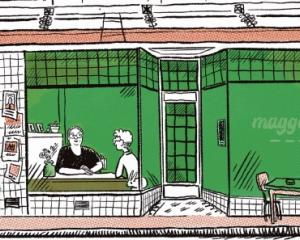THE THREE BURIALS OF LOTTY KNEEN
Krissy Kneen
Text Publishing
REVIEWED BY JESSIE NEILSON

With her thick Slavic accent, irascibility, and protective walls, Lotty refuses to speak about earlier generations or her own movements across the world. She refers to Slovenia as ‘‘a horrible place’’, ‘‘No Man's Land’’, forbidding her granddaughter from visiting. What Kneen can glean is that Lotty was born during World War 1, in the former Austro-Hungarian Empire, fleeing alone as a young child to Alexandria. She fled again in 1956 during the Suez Crisis and made her way to England with two small girls, and finally, Australia.
Thoroughly Australian, Kneen does not speak Slovene or know cultural history. Upon Lotty's death, Kneen attempts to rectify this, reading about the krivopete, wild women, and other creatures of folk lore which so inspired her grandmother in her papier-mache creations. Lotty had brought up her daughters and granddaughter on a remote property in New South Wales where she opened Dragonhall, a little-visited tourist attraction. Fairy tales were cautionary, and Kneen felt trapped in her own one, in a ‘‘witchy’’ house.
Lotty's whole life is a cautionary tale for the following generations, with especial care to be taken around men. Such an enigma piques Kneen's curiosity, and she, from storytelling lineage, invents her own back stories for her ancestors. Great-great-grandmother ‘‘Anastazija’’ is placed in the mountain village of Miren.
While there is no forensic proof of this, Kneen gives her the puff of breath from her lungs, filled with Vipava river water. Kneen is interested in science and mingles biology and myth together. She describes genetic material passed down, of bacteria still swirling through their bodies. The grip of her grandmother is always strong, and even after Lotty's death, Kneen frequently imagines her grandmother curled up inside her belly, tapping her finger in her chest or sinking her teeth into her intestines.
Kneen's story is a fresh mix of biography, memoir, science, and folk lore. While she values rigorous scientific testing, she also sees a place for the storytelling legacy. She appreciates her reality and adds folk elements such as dragons and podmenek or changelings, the skok, the malvorar, and the salamander, in which their family has always believed.
There is a constant pull and threat of good and evil, of strangers and outsiders, of remembering and forgetting. Physicality is ever-present, Kneen lamenting her struggles with her weight and self-worth, the ‘‘sheer unSlovene-ness’’ of her body.
When she finally makes it to Slovenia, she tries to reconcile her presence in this very traditional country. She carries with her a small vial of ashes, for the burying of her grandmother, her memory, and her influence, is ongoing. Like the earlier generations of women, Lotty's spectre is random and recurrent.
Kneen's investigations take her and the reader into surprising pockets of history. Hugely interesting is what she uncovers of the Aleksandrinke, the earlier generations of Slovene women who worked as nannies in Alexandria prior to 1956. Therefore, while this is a personal delving, which only manages to be partially successful, it is also a journey into the wider cultural history of Slovenia.
This story soars far and wide between remote Australia, mid-century Egypt, and modern-day Slovenia; it is a generous and joyfully spirited adventure which embraces embellishment, fantasy, and uncertainty. While pulling at threads of genetic history, Kneen accepts this can only ever be incomplete.
Jessie Neilson is a University of Otago library assistant












